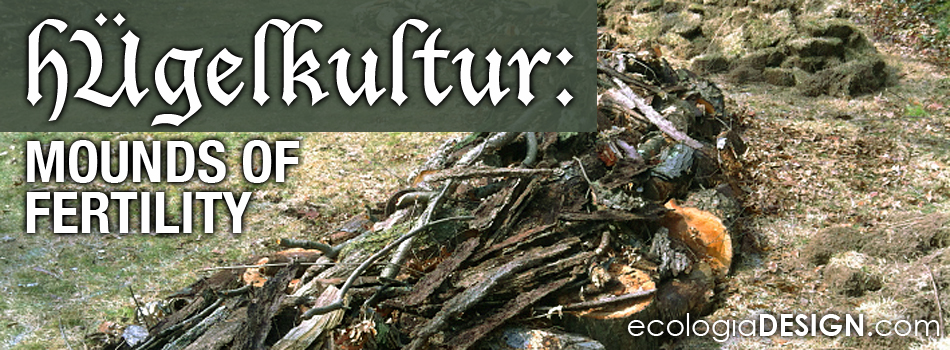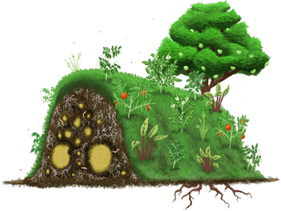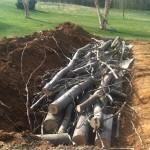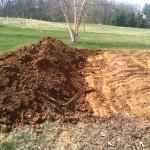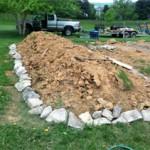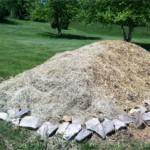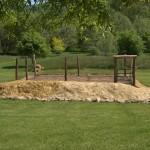Get my Hugelkultur Chapter From Edible Landscaping with a Permaculture Twist!
Hugel – What??
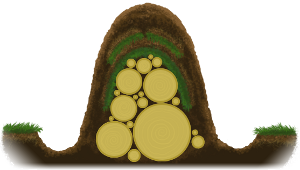
Hugelkultur is basically just woody debris covered in sod and soil to imitate what happens on the forest floor – creating a the most fertile and moist beds. Illustrations courtesy of Paul Wheaton and richsoil.com.
“Hugelkultur” roughly translates from German to mean “mound culture.” It’s an ancient practice of creating raised garden beds by covering wood with soil.The buried wood acts like a sponge, capturing water and nutrients for later use by whatever you choose to plant. As it decomposes, the wood draws in beneficial fungi and quickly turns into rich soil. The results are astounding for such a simple process and creates the most amazing,fertile, and self-hydrating raised beds!
What’s Great About Hugelkultur
- Amazing Water Retention
- Warmer Soil
- Builds Soil Fertility
- Creates Micro-Climates
- Recycles Organic Matter On-site
- Less Bending Over!
- Cleans Your Yard up in Style
How It Works
A hugelkultur bed imitates a forest floor. Woody material falls, absorbs moisture, then decays, thus feeding the nutrient cycle and plants around it. By covering wood with sod, soil, and/or compost, you create a moist environment perfect for fungi to colonize. Fungi quickly begin to break the wood down into the most fantastic planting soil and stage the bed for worms and other soil builders. As the buried, decomposing wood breaks down, it gives off heat—as all compost does—and opens up tiny air pockets, creating optimal soil conditions for plants to thrive. (The nitrogen will be tied up in the wood decomposition for the first season, if it’s new wood, but then the tables turn and the nutrients release like a flood).
Where and How?
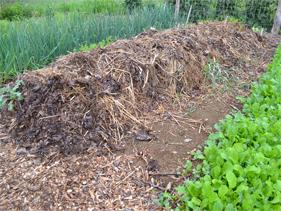
Small-scale hugelkultur beds from pruning’s fit well in the raised bed garden. The hugel beds here show recently created mounds here and the same bed two years later below, planted for chicken fodder at Harvey Ussery’s homestead. www.themodernhomestead.us.
Just by chucking some soil on top of a wood pile, you can turn inhospitable areas—compacted, wet, or dry—into thriving, growing systems. Hugelkultur beds can be built up with any size or age of wood, from branch trimmings to huge chunks of wood … even whole trees. The taller the pile (up to six feet), the better. Taller piles will hold more moisture in their decomposing, woody mass. A tall hugelkultur bed can also serve as an immediate barrier to road noise, unsavory neighbors, etc.
That said, even a 1 or 2 foot-high micro hugelkultur can take advantage of using smaller debris and become a fertile pile of sticks!
Building a Hugelkultur Bed
This is a simple, straightforward process:
- Pick a site for your bed—an area at least 3 feet wide by 6 feet long. Ideally, you can site a hugel bed on contour or perpendicular to the slope to harvest rain water runoff, adding to the bed’s hydration and plantings downslope.
2. Gather your materials:
- New or old wood of all sizes (avoid locust, walnut, cedars, pines, and other trees that are slow to break down or contain tannins)
- Sod, leaves, manure, kitchen compost
- Top soil
- Straw
3. Layer the woody debris, starting with the largest diameter on the bottom, becoming smaller as you rise up. Any height works, but the higher, the better to allow for longer moisture retention.
4. Stuff the gaps with upturned sod, leaves, compost, or manure.
5. Cover with at least two inches of top soil, then add straw as mulch. If the bed is tall, you may need to secure the straw by pinning it down with V-shaped twigs or by leaning branches against the pile.
Sink It
Hugelkultur beds come in just about every style, fashion, and size. The simplest is a well-packed pile of wood debris laid directly on the ground, then covered with top soil and straw, as outlined above. This alone will work wonders, but sunken hugelkultur beds also have their benefits.
Build a sunken bed by excavating the width and length of the bed 1 to 2 feet deep, separating the excavated sod and soil for later reapplication. Lay the woody debris down in the excavated bed, then build up as described above. This approach has a stronger water-harvesting element, since it also acts as a swale if dug on contour (see Raised Beds post). A big benefit of excavating first is that it provides the sod and soil needed to cover the pile of wood.
You can create your own variation of a hugelbed; the concept is adaptable to your site, materials, and imagination. Be patient and you will be rewarded with the most amazing, fertile beds. Ninja move: if you have fresh, healthy wood cut while dormant you can inoculate the wood with oyster or shiitake strains before putting in the hugelkultur.
The hugelkultur bed in the series below was designed to capture a large volume of water coming downslope and hydrate a garden below. Excavated with a small Bobcat on contour and filled with storm-fallen poplar logs and brush. The sod was placed to one side and laid on top of the wood before layering on the soil. The bed was then edged with stone, covered with straw, and seeded with cow pea as a cover crop. This hugel bed now harvests a huge volume of rain water runoff passively, both for itself and also for the raised bedgarden below. Win, win!
Planting the Hugelkultur
If the season allows it, sow a cover crop immediately after building the hugelkultur. I sow whatever I have on hand—clovers, cow peas, vetch. Remember that the first year, nitrogen will be tied up in the decomposition process of the wood, so be patient. After a full growing season, the hugel will have dropped in height by a third, and will have built up nutrient levels and moisture retention. At this point, you can continue with the cover crops for another season and/or begin to plant in other annuals and perennials.
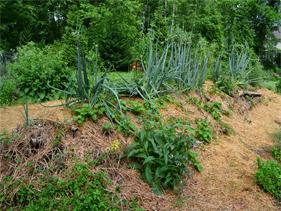
Hugel bed entering its second season at the Judd’s Long Creek Homestead. Bed has already dropped three feet and is holding moisture and releasing nutrients from the decaying wood.
A large hugel bed will hit its stride in the third year; smaller hugel beds will be ready as early as the second season. Berries seem to love hugel beds and make for a great picking height. I plant blueberries, lingonberries, raspberries, figs and hazel nuts, mixed in with rhubarb, comfrey, sage, Egyptian walking onions (the funky guys popping out in the picture below) and black-eyed Susans that will all eventually turn into a fedge!
Try playing with the micro-climates on the hugel; i.e., plant cool-weather plants on the north or east side, and warm-loving ones on the south or west. You will be amazed at the growth and flavour. Hugel beds grow the tastiest fruits that can be used to create your own fine wines.
However you plant it you will get great returns, just for chucking some dirt on wood. Love it!
How Hugelkultur Saves the World
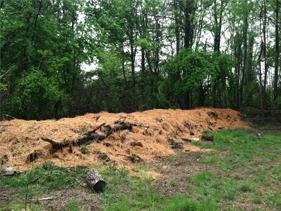
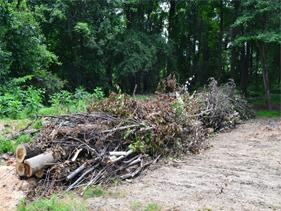
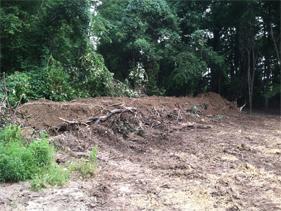 Hugelkultur is a great way to recycle and capture the resources produced by the land. Ideally, all of the resources coming into or onto our sites are captured and stored, with water and organic matter being the most tangible. I often come across folks who are piling up branches and leaves by the roadside for pickup. That debris usually ends up in a landfill, where it breaks down slowly, and definitely is not used to its full potential. This is an incredible loss to the site, as those branches and leaves can be easily transformed into great growing material.
Hugelkultur is a great way to recycle and capture the resources produced by the land. Ideally, all of the resources coming into or onto our sites are captured and stored, with water and organic matter being the most tangible. I often come across folks who are piling up branches and leaves by the roadside for pickup. That debris usually ends up in a landfill, where it breaks down slowly, and definitely is not used to its full potential. This is an incredible loss to the site, as those branches and leaves can be easily transformed into great growing material.
Another great “waste” source is soil. It is not hard to find someone in the neighborhood digging up the earth for a variety of reasons. Often, those people are looking to get rid of the soil, which is a perfect opportunity for a hugelkulturist. For example, you can build a rain garden and hugelkultur at the same time, using the excavated soil and sod from the rain garden to cover the hugelkultur bed.
In building our circular round-wood timber-frame strawbale house, we did a little site-clearing for access and safety. Instead of hauling the wood offsite and setting up artificial erosion fences (which is the norm in house site construction), we piled it high and covered it with the soil from the foundation excavation. We recycled all the materials onsite into multiple hugelkultur beds that harvest all the rainwater runoff and erosion. Now we will have fertile garden beds for planting when we move in.
This wonderfully illustrated hugelkultur and swale combo below – modified by the fine folks at Midwest Permaculture from Bill Mollison’s “Introduction to Permaculture” – stacks the functions of passive rainwater harvest, organic matter recycling, and food forest design. Ninja design at its best. Midwest Permaculture also has good videos on hugelkultur design at www.midwestpermaculture.com. Note: The (N) next to some of the listed species denotes them as nitrogen fixers.
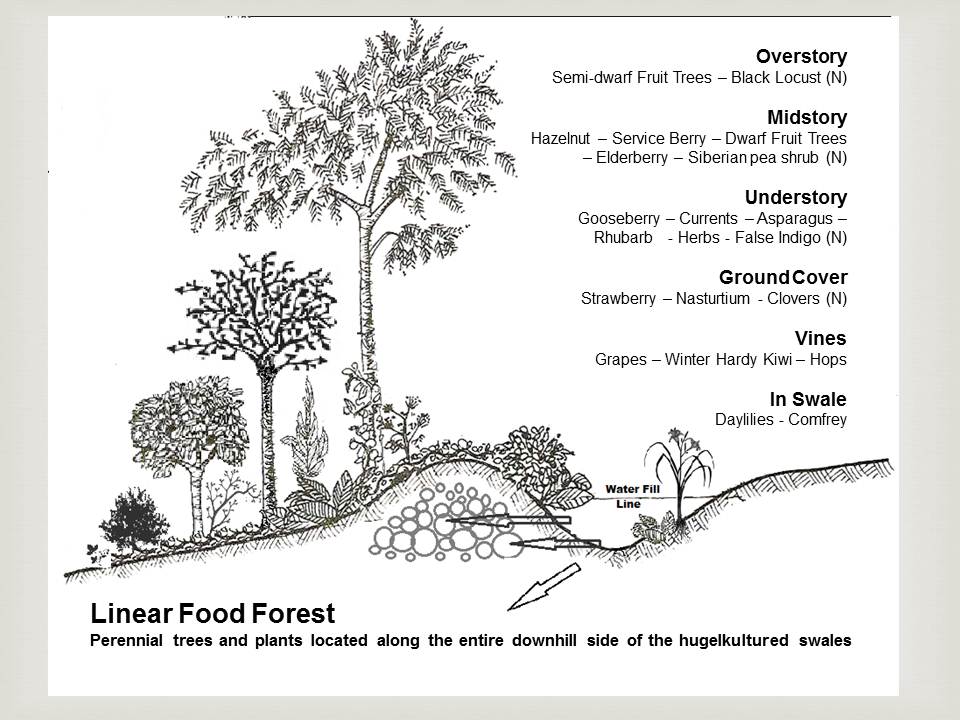 For further design ideas and inspirations, check out the works of two of the finest hugelkulturists around: the almighty, glorious Sepp Holzer; and the Duke of Permaculture, Paul Wheaton. These guys are proving the fertility of hugelkultur beds in the extremes of the Austrian Alps and the Montana Rockies. They are truly Hugelkultur Ninjas!
For further design ideas and inspirations, check out the works of two of the finest hugelkulturists around: the almighty, glorious Sepp Holzer; and the Duke of Permaculture, Paul Wheaton. These guys are proving the fertility of hugelkultur beds in the extremes of the Austrian Alps and the Montana Rockies. They are truly Hugelkultur Ninjas!
Paul Wheaton is this superbly obnoxious guy out in Montana that has dedicated himself to building an empire of permaculture knowledge and resources, earning the title “Duke of Permaculture.” He has more than 100 podcasts filled with humor, rant, and gems of insight for navigating the complexities of the permaculture world. His online forum is an encyclopedia of real-life knowledge and experience from a large and responsive community. You can search specific challenges others have encountered when putting designs together, or you can post your specific issue for a diversity of replies and approaches at www.permies.com.
Resources
“Edible Landscaping with a Permaculture Twist” by Michael Judd
http://www.richsoil.com/hugelkultur/- A great hugelkultur article by Paul Wheaton
“Sepp Holzer’s Permaculture: A Practical Guide to Small-Scale, Integrative Farming and Gardening – An awesome book by Sepp Holzer!
Posted In: Edible and Ecological Landscape Design

